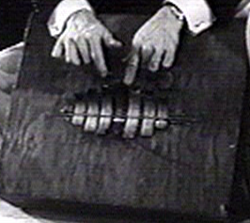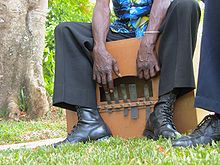- Marímbula
-
Marímbula 
MarimbulaA marímbula (Spanish pronunciation: [maˈɾimbula]) is a folk musical instrument of the Caribbean Islands (not to be confused with a marimba). The marímbula is usually classified as part of the lamellophone family of musical instruments. With its roots in African instruments, marimbula originated in the province of Oriente, Cuba in the 19th century. Eventually it spread throughout the Caribbean the Americas and Africa, from Liberia to the Congo. By the 1930s it had made its way to Haiti, the Dominican Republic, Puerto Rico, Jamaica, other Caribbean islands, Mexico, and as far away as New York City. The Cubans call it marímbula, and most of the other Caribbean countries have adopted this name or some variant of it: marimba, malimba, manimba, marimbol. The instrument has a number of other names, such as marimbola (Puerto Rico), bass box (also spelled Calimba or calymba), Rhumba box, Church & Clap, Jazz Jim (Jamaica), and box lamellophone.
Musicologists classify it as a lamellophone. The sound of a marimbula is produced by plucking the free ends of springy plates ("tongues" or keys) attached by one end to a resonator box.
African slaves of the Caribbean made musical instruments from whatever stray material they could lay their hands on. Early marimbulas were made from discarded wooden packing crates, with tongues (keys) made of springy wood, bamboo, old hack-saw blades, all kinds of discarded springs, etc. The musician sits on top of the box reaching down to pluck the tongues whilst slapping the sides of the box like a drum. The instrument's evolution and playing style is similar to that of the cajon box drum. Watch the video of Cuban musicians playing Changui in Guantanamo the birthplace of Changui music at the following link.[1]
This instrument was very important in the development of Afro-Cuban music as it was one of the basic instruments played by the Changui musicians. Changui music is the predecessor of the ever present Son genre. Both Changui and Son genres developed as a result of the combination of African and Spanish musical styles and instrumentation. Thus, the Changui musicians of today still play a pair of tack-head bongos, Marimbula, a pair of maracas, Guiro and Tres to accompany the voice of the vocalist and chorus. All of the above mentioned instruments are handmade folk instruments, made from locally available materials, as opposed to commercially produced instruments.
This was one of the many instruments imported from the Americas to Africa, which continue to be played to this day, in various forms and styles, particularly in the countries of Sierra Leone, Liberia, Guinea, Ghana and Nigeria.
Designs of marimbulas vary greatly, in terms of the material of resonator, the number and arrangement of keys, the overall arrangement and size of the instrument and the way it is played.
Unlike typical African lamellophones used to produce complex polyphony and polyrhythms, the marimbula basically plays the role of a bass guitar, to provide the rhythmic and harmonic support for a band, although it can produce a simple melody as well.
The Marimbula became quite popular in Jamaica in conjunction with guitars, drums, maracas and vocals in the churches, where it was known as church and clap, in the nightclubs where it was known as Jazz Jim and among the various hotel performers, who played mento music. It can still be found in use among mento musicians today, such as the Jolly Boys.
It is fairly easy to learn to play the marimbula, especially for those who have a grasp of some other musical instrument, since no intricate technique is involved.
Currently, the instrument is regaining popularity among hip hop artists and mbira players, like Chartwell Dutiro and The Jolly Boys.
References
External links
- View photos of marimbulas
- The Story of the Marimbula
- Modern marimbula workshop
- Another page on the marimbula with examples
See also
- Prempensua, a similar instrument used in the music of Ghana
- Kalimba
Categories:- Lamellophones
- Cuban musical instruments
- Pop culture words of Bantu origin
- African musical instruments
- Contrabass instruments
Wikimedia Foundation. 2010.

